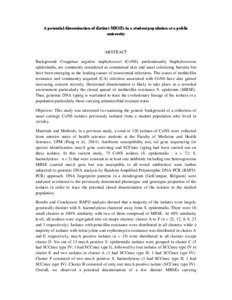Citation
Pung, Hui Ping and Amin Nordin, Syafinaz and Tengku Jamaluddin, Tengku Zetty Maztura and Mohd Desa, Mohd Nasir
(2015)
A potential dissemination of distinct MRSEs in a student population at a public university.
In: Infections 2015, 7-8 Apr. 2015, IOI Marriot Putrajaya, Malaysia. (p. 30).
Abstract
Background: Coagulase negative staphylococci (CoNS), predominantly Staphylococcus epidermidis, are commonly considered as commensal skin and nasal colonizing bacteria but have been emerging as the leading causes of nosocomial infections. The issues of methicillin resistance and community acquired (CA) infection associated with CoNS have also gained increasing concern recently. Horizontal dissemination is likely to take place in a crowded environment particularly the clonal spread of methicillin resistance S. epidermis (MRSE). Thus, genomic DNA typing is warranted to trace the evolutionary lineage of the isolates in a population particularly those carrying antimicrobial resistant traits.
Objective: This study was interested in examining the generic background of a collection of nasal carriage CoNS isolates previously isolated from a student population who lived in vicinity.
Materials and Methods: in a previous study, a total of 120 isolates of CoNS were collected from anterior nares of health sciences students at the Faculty of Medicine and Health Sciences, UPM (Pung et al., 2014). Antibiotic susceptibility test, tuf gene sequencing for species identification, mecA gene screening and SCCmec typing had been carried out on these isolates. In this current study, 75 CoNS isolates (S. epidermidis : n = 72; S. haemolyticus : n = 3) that were resistant to at least one antibiotic including one heterogeneous MRSE (carried mecA gene but was susceptible to all tested antibiotics) were further subjected to genomic DNA analysis by Random Amplified Polymorphic DNA-PCR (RAPD-PCR) approach. DNA fingerprint patterns in a dendrogram (GelCompar, Belgium) were analysed in relation to the previously determined phenotypic and genotypic properties of the isolates in order to trace the potential clonal dissemination of the isolates in the studied population.
Results and Conclusion: RAPD analysis showed that a majority of the isolates were largely genetically distinct with S. haemolyticus clustered away from S. epidermidis. There were 16 small clusters at 100% similarity with two of them composed of MRSE. At 40% similarity level, all isolates were segregated into six major clusters: cluster A to F (n = 22, 12, 8, 8, 23 and 3 respectively). Isolates with penicillin resistance were distributed in all clusters, while a majority of isolates with tetracycline and erythromycin resistance was distributed in cluster A and E respectively, mecA positive isolates (n = 15) were distributed in all clusters except cluster D. Six out of 13 mecA positive S. epidermidis isolates were grouped in cluster C (5 had SCCmec type IV; 1 had SCCmec type I), followed by four isolates of SCCmec type IV in cluster E and two isolates in cluster A (1 had SCCmec type II; 1 had SCCmec type IV). Cluster F consisted of two mecA positive S. haemolyticus (1 had SCCmec type II, 1 had SCCmec type IV). Cluster B consisted of only one mecA positive isolate (SCCmec type IV). Overall, we observed a potential dissemination of a few distinct MRSEs carrying predominantly SCCmec type IV in the population rather than a clonal spread. Thus, to reduce the risk of potential emergence and dissemination of MRSEs at a larger extent, there is a need to instill awareness on proper hygiene practice in the student population.
Download File
![[img]](http://psasir.upm.edu.my/65591/1.hassmallThumbnailVersion/A%20potential%20dissemination%20of%20distinct%20MRSEs%20in%20a%20student%20population%20at%20a%20public%20university.pdf)  Preview |
|
Text (Abstract)
A potential dissemination of distinct MRSEs in a student population at a public university.pdf
Download (39kB)
| Preview
|
|
Additional Metadata
Actions (login required)
 |
View Item |

